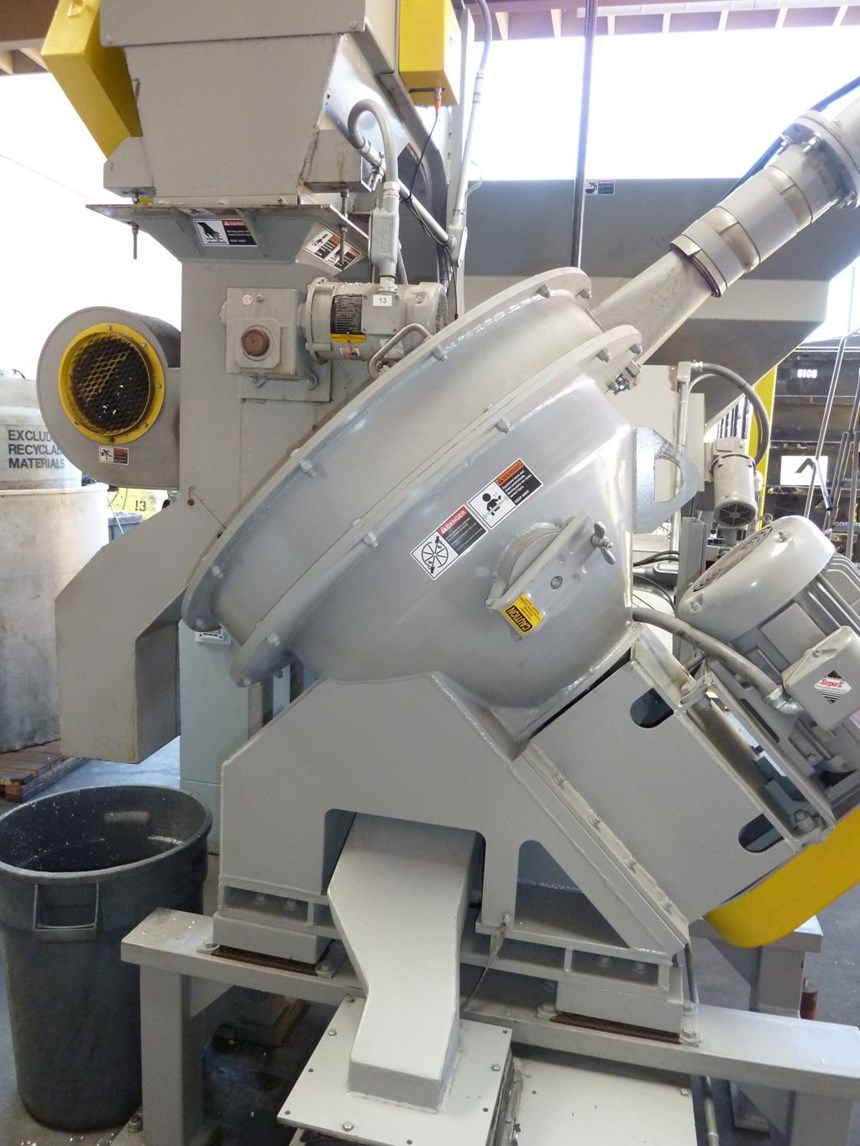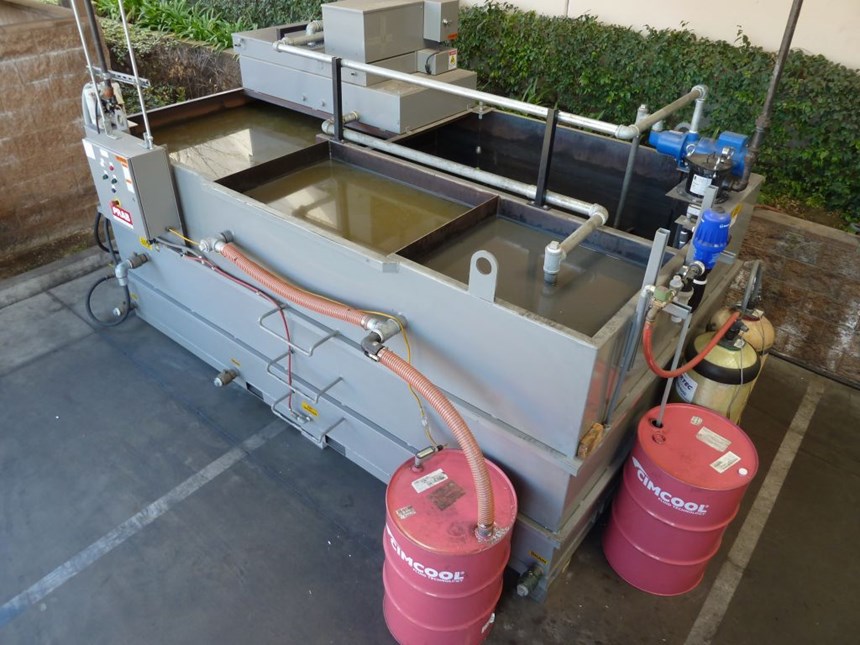Cashing in Your Chips
By installing a new chip processing and coolant filtration system, this aerospace manufacturer raised the value of its scrap, slashed new coolant costs and mitigated its environmental impact, shielding itself against potential fluid disposal liabilities.
Share




ECi Software Solutions, Inc.
Featured Content
View More


Hwacheon Machinery America, Inc.
Featured Content
View More



The more chips a company cuts, the better. But once the output reaches a certain volume, it may be time to look beyond traditional disposal methods toward more efficient systems. New chip processing equipment, linked with coolant filtration systems, can raise the value of scrap metal going to the recycler, reduce material handling and maintenance concerns, filter coolants for reuse in machine tools, and help a company achieve ISO 14001 environmental compliance.
These are just a few of the benefits being realized by Brek Manufacturing Co. since installing the first of three such systems it has purchased for its operations in Gardena, California, just south of Los Angeles. “I would say that if a company is producing in the neighborhood of a million pounds of chips each year, they need to seriously consider looking into this type of system,” says Marwan Hammouri, president and CEO. “Because if they haven’t, it’s likely that they’re throwing money away.”
Monolithic Manufacturing
Since 1968, Brek has been manufacturing complex structural parts for the aerospace industry such as spars and bulkheads to be mounted within an airframe. These parts are made of aluminum, and they are produced using three-axis CNC milling machines for simpler pieces and five-axis machines for more complex parts. All of these machines—two-, three- and four-spindle bridge and gantry mills—bear the Cincinnati Milacron brand, now part of the Fives Group. The majority of Brek’s work involves producing “monolithic” structures via five-axis machining. “The term ‘monolithic’ refers to manufacturing and joining component parts into a single structure,” Mr. Hammouri explains. “Whereas an aircraft company once had to order all the component parts that make up a large structure individually, it can now use a single part number for the completed structure, which really simplifies the process.”
With more than 99 percent of its machining activities involving high-speed milling—most of its machines are rated at 10,000 rpm and higher—the vast majority of the chips it produces are fairly thin and curled, like silver wood shavings, while chips from higher-speed operations are shorter and straighter. The only time it produces what is known as a “bird’s nest” is when it conducts fly milling, during which a cutter skims a flat surface prior to end milling, creating long tendrils of aluminum that tend to cling together in a tangle. Historically, these metallic knots presented problems such as forming clogs in various chambers within chip processing equipment. This operation is used so infrequently at Brek, however, that the company’s primary focus is on the disposal of the more familiar short, curved chips.
When Mr. Hammouri joined the company last July, he found that Brek was using a chip processing system that formed the scrap into shapes resembling thick hockey pucks. He sees this as one of three primary methods for handling the scrap produced by machine tools.
“I came to Brek from Triumph Structures,” he says, speaking of the aerospace manufacturer located in Wichita, Kansas, “where I had been president for the previous 13 years. While I was there we had moved from disposing of ‘wet chips’ from which the coolant had not been separated, to using ‘pucking sytems’ to compress the chips and partially drain fluids, to installing an early chip processing and coolant filtration system, so I was familiar with the pros and cons of each.”
Chip Theory
According to Mr. Hammouri, the most basic approach to chip disposal, of course, is for a company to simply allow a recycler to remove wet chips from which coolants have only been partially drained. While this may seem the easiest way to get rid of chips, the problem is that payments are negotiated according to weight, so the manufacturer is paying to have the coolant taken away along with the chips. Recyclers weigh the scrap for moisture content, but the weight differs according to whether samples are taken from high in the heap, where the chips are dryer, or lower, where they tend to be saturated with more coolant. In other words, the manufacturer has very little control over the accuracy of the moisture content test results and, therefore, the price per pound it will receive. “Generally, though, wet chips are considered to be about 25 percent moisture,” he says.
One risk associated with this method involves liability should a lawsuit be filed against a recycler that disposes of hazardous materials improperly. The more used coolant or machine oil a manufacturer sends to the recycler, the greater the chance of being implicated if disposal problems should arise down the road. By proactively addressing fluid reclamation, manufacturers can help shield themselves from liability by proving good intent.
The second method, pucking, does force out coolant as it condenses the chips, but moisture content of about 10 percent remains, which a manufacturer is unable to reuse and is paying to have hauled away. In addition to the potential liability associated with any disposal issues involving this coolant, there are also equipment maintenance concerns due to the forceful mechanical action of the pucking process. The toll this action takes on the machine often leads to downtime and the associated repair costs. And although more material can be loaded into recycling bins in the puck form due to its density, there is still a certain amount of wasted space in these bins.
The latest scrap-handling technology, recently adopted by Brek, involves a processing system that crushes chips into a uniform shape and size, automatically sends them through a “tramp metal” separator to remove larger pieces such as bolts or other items that have mistakenly fallen into the chip bin so as not to damage the system downstream, then separates the water-soluble coolant from the chips via centrifugal force. Dry chips are then automatically loaded directly into bins for pickup by the recycler and the coolant is pumped into separation tanks and then a filtration system. The latter process removes both tramp oils and particulates. “The coolant itself is not a biohazard,” Mr. Hammouri says. “The toxic elements are a result of the metal it comes in contact with, as well as the machine oils that seep into it during the machining process.”
Tailored Technology
In light of Mr. Hammouri’s previous experience with an earlier version of this processing/filtration system, the decision was made to work with the OEM, PRAB Inc., on a new system custom-designed for Brek to eventually replace its pucking system. Design improvements had been made, resulting in a robust system that automated the entire process once chips had been loaded into the hopper and could handle both standard chips and bird nests with equal ease.
As any company considering implementing a system of this nature would, Brek had to take the physical layout of its own operation into consideration in choosing the configuration that would best suit its needs. Mr. Hammouri points out that most machine shops start out small and grow larger over time, adding space and additional facilities as best it can. “You rarely have the opportunity to create a comprehensive plant layout from the start,” he says. “You begin with a few machines and then add more, so you will often find various operations housed in different buildings that are not contiguous.”
Brek—which has three manufacturing facilities and other buildings totaling 140,000 square feet located near one another in an industrial center, but still separated by streets—deemed it necessary to purchase three separate systems to be located at different sites across its campus. “The optimal design would involve underground chip conveyors leading from all of a company’s machine tools to a centralized processing center, which is indeed an option,” Mr. Hammouri says. “But in reality, that’s not the way most machine shops grow.”
Not only did buying three systems at once lower the total price, it also allowed Brek to install one after another, applying what it had learned in the previous installation process to the next. With the first system in operation since last summer, the second is ready to go online, and the third will be put in place soon after. The company was sure to have a backup plan handy during the initial phase of the new system’s operation. “We ran our new PRAB system alongside our old pucking system until we were sure that we’d learned all we could about its operation and had completed any necessary modifications,” he says. “Even when the new system is ready to take over the complete operation, however, it’s always a good idea to have a backup plan, even if it only involves having a spare container on site in which to store scrap should you experience any unexpected downtime.”
Efficient Operations
Now in operation for more than six months, the first system installed has performed well, simplifying a formerly arduous task and calling for very little maintenance, especially when compared to the pucking machine. The chip processing machine is topped by a large hopper with a low-speed, high-torque arm circulating in its basin that crushes the aluminum chips. Mike Price, Brek’s facilities manager, points to the compact nature of the system’s footprint.
“Once chips enter the machine, they are crushed automatically before a conveyor loads them into the trash metal separator, where anything that doesn’t belong in the mix is segregated into its own bin,” he says. “The scrap then enters the wringer, which separates the coolant from the chips.”
The chips, now dry, are transferred by an overhead pneumatic pipe system directly from the wringer to 23-foot-long containers for the recycler to haul away with their trucks. The main pipe branches into two tubes where chips are directed by a valve from a full to an empty container. When a container is full, a sensor generates an email notifying both Brek and its recycler that it is ready to be taken away. The captured water-soluble coolant is then channeled into the coolant recycling system and passes through a permanent coalescing media that removes the tramp oils. It is then sent through a polishing filter to remove fine particulates and returned directly to the machine tools for reuse.
Good Stewards
The market constantly puts pressure on manufacturers to make cost reductions in order to remain competitive. There are also certain intangibles, such as environmental awareness, that shine a favorable light on a company seeking new contracts. Mr. Hammouri lists the ways in which the company’s new chip and coolant processing system helps Brek achieve all this, and more.
“Whether we are pursuing a new customer, or a new contract with an existing customer, it’s important to show that we are paying close attention to every aspect of our operation,” he says. “Being in control of the moisture content of our chips means we’re getting the best price from our recycler. Being able to recover and reuse more than 90 percent of our coolant leads to lower new-coolant purchasing costs. And customers can be confident knowing that we are doing our best to be good environmental stewards by minimizing the toxins that are produced in the manufacturing environment. Paying attention to details such as these really add to a company’s bottom line, as well as its reputation.”
Related Content
Solar Atmospheres Receives Northrop Grumman Approval for South Carolina Facility
All five Solar Atmospheres facilities are now an option for customers with Northrop Grumman requirements for vacuum heat treating.
Read MoreAFRC, ATI Partner to Boost Aerospace Materials Innovation
ATI Inc. has joined the University of Strathclyde’s AFRC as a tier one member, aiming to develop metallic alloys that support sustainability in the aerospace sector.
Read MoreSandvik Coromant Inserts Provide Stable Turning of Aerospace Components
The new insert grades GC1205 and GC1210 cover a large application area within last-stage machining and intermediate-stage machining when turning aerospace engine components.
Read MoreMachine Monitoring Boosts Aerospace Manufacturer's Utilization
Once it had a bird’s eye view of various data points across its shops, this aerospace manufacturer raised its utilization by 27% in nine months.
Read MoreRead Next
Registration Now Open for the Precision Machining Technology Show (PMTS) 2025
The precision machining industry’s premier event returns to Cleveland, OH, April 1-3.
Read MoreBuilding Out a Foundation for Student Machinists
Autodesk and Haas have teamed up to produce an introductory course for students that covers the basics of CAD, CAM and CNC while providing them with a portfolio part.
Read More5 Rules of Thumb for Buying CNC Machine Tools
Use these tips to carefully plan your machine tool purchases and to avoid regretting your decision later.
Read More












































.jpg;maxWidth=300;quality=90)










